First World War Project
William Charles DRAYSON (of Lynsted)
b. Q1 1881 Corporal, Service Number G/3969 |
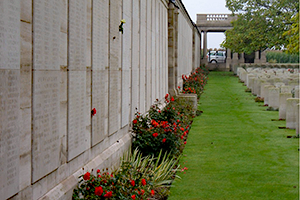
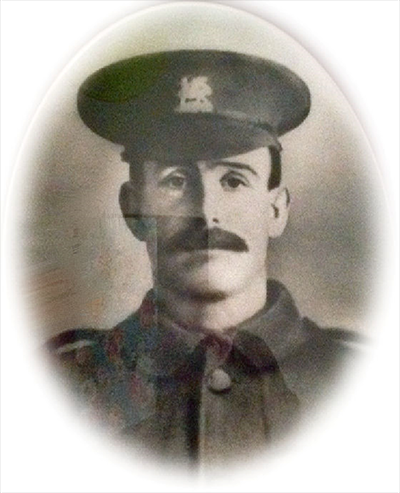 William was the third of 16 children born to Robert Henry Drayson, a market gardener, and Sarah Jane (known as Jane), née Hammond. He was born in 1882 in Eastry, Kent, and christened in the Church of St Mary the Virgin in Woodnesborough on 17 December that year. Elder siblings were Edith Ellen and Robert Hammond. His younger siblings were Gertrude Mary, Herbert John, Richard Bushell, Rosa, Lucy Jane, twins George and Harry, Frederick Thomas, Alice, Maud, Dorothy, Cecil George and Lillian Grace. Gertrude, George and Cecil died in infancy and predeceased William.
William was the third of 16 children born to Robert Henry Drayson, a market gardener, and Sarah Jane (known as Jane), née Hammond. He was born in 1882 in Eastry, Kent, and christened in the Church of St Mary the Virgin in Woodnesborough on 17 December that year. Elder siblings were Edith Ellen and Robert Hammond. His younger siblings were Gertrude Mary, Herbert John, Richard Bushell, Rosa, Lucy Jane, twins George and Harry, Frederick Thomas, Alice, Maud, Dorothy, Cecil George and Lillian Grace. Gertrude, George and Cecil died in infancy and predeceased William.
On 2 June 1906, William married Lily May Weaver at All Saints Church, Stourmouth, Kent. The couple settled in Woodnesborough, during which time William was working as a fireman in the colliery. In 1907, their first daughter, Christina May, was born, followed in 1909 by a second, Ivy Kathleen. Sadly, after just 6 years of marriage, Lily died of tuberculosis in September 1912 aged just 27. Lily is buried in the churchyard of St Mary the Blessed Virgin, Woodnesborough. Christina and Ivy were just 3 and 6 when they lost their mother. Two years later they also became separated from their father on the declaration of war.
William enlisted in the 6th (Service) Battalion, The Buffs at Margate. The Battalion was formed at Canterbury in August 1914 as part of the First New Army (K1) and moved swiftly to Colchester. The first arrivals there found nothing but empty barracks that had been vacated in haste. The Battalion was soon up to strength but men kept arriving and the camp soon became over-crowded. An extract from "The Historical Records of The Buffs" describes life at the camp:
"Anyone who served with one of Kitchener's battalions during the latter part of 1914 and the beginning of the following year will remember what it was like. Genuine hard work and honest efforts on the part of all to make bricks with so very little straw. It is easier to collect heroes for the defence of their country than to arm, clothe, and equip them; and the number of men got very far in advance of the amount of necessities for them. A new battalion at this period was not a pretty sight. A very ugly shoddy suit of blue was doled out to the soldier, with a civilian greatcoat and generally a dummy rifle, and with this turn-out he did real strenuous drill and training. Old service rifles, for drill purposes only, began to come in later on, and the men gradually obtained sufficient blankets and clothing. Nothing daunted the spirit of the troops, however, and life was cheery enough."
On 6 November, the Battalion returned to Kent, being based at Sandling Camp, near Shorncliffe. The camp quickly became a quagmire owing to heavy rain and bad drainage. The huts even became uninhabitable with some soldiers erecting their tents inside to keep off the rain. With Christmas approaching, the soldiers moved out and into billets in the villages of Elham and Lyminge, where they were given a generous welcome by the community. The Battalion remained in these billets during January and, on the 31 January, they attended a special service in Canterbury Cathedral that had been arranged by the Dean.
The Battalion then moved to Aldershot for more advanced training that lasted until 1 June when, now part of the 37th Brigade of the 12th Division, they were mobilised and left for France. After one night in Boulogne, they were entrained for St Omer and then marched to Remilly-Werquin.Here they rested for 3 days before, during very hot weather, marching to billets and bivouacs at Meteren, near Bailleul.
On 12 June, William's Battalion moved up to Armentieres to undergo trench warfare training before moving forward to the real thing. The remainder of his summer was spent alternating between the trenches and resting in leaking, uncomfortable and crowded billets.
The Battalion took part in the Battle of Loos (25 September to 8 October 1915) and, along with other battalions, suffered heavy losses. By the end of October the Battalion was low in numbers and was employed in work such as fetching and carrying for the Royal Engineers. In November, they saw fighting around Hohenzollern Redoubt. Then, in a very wet and cold December, they saw fighting in trenches at Givenchy and Festubert. A weary Battalion then faced the long monotony of the winter.
It is clear that William's war was hard fought. In his final months he experienced what was the coldest winter of the war. Trenches were waist deep in mud and men lived, and in some cases drowned, in these appalling conditions. His last 3 months were spent almost entirely in the trenches, starting in 1916 under bombardment.
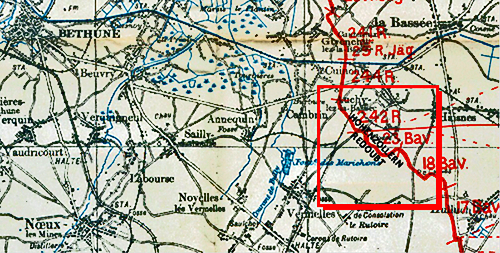 At the beginning of March, William's battalion took up their positions in the trenches near the Hohenzollern Redoubt. This was a defensive strongpoint of the German 6th Army. This area had, over the winter months, been tunnelled by the British 170th Tunnelling Company. The enemy's view of the British Positions was unobstructed and the intense shelling over the past few weeks had turned no man's land into a crater field. On 2 March, four mines (the largest yet used by the British) were detonated, followed by a British advance towards the German lines under orders to occupy any crater within 60 yards of our line.
At the beginning of March, William's battalion took up their positions in the trenches near the Hohenzollern Redoubt. This was a defensive strongpoint of the German 6th Army. This area had, over the winter months, been tunnelled by the British 170th Tunnelling Company. The enemy's view of the British Positions was unobstructed and the intense shelling over the past few weeks had turned no man's land into a crater field. On 2 March, four mines (the largest yet used by the British) were detonated, followed by a British advance towards the German lines under orders to occupy any crater within 60 yards of our line.
The only Victoria Cross awarded to William's battalion was to Corporal William Cotter for his action on 6 March 1916.
Military records report that on the day William died, there was much confusion. Between 5am and 7am, 2,000 shells had rained down. Gas shells and damage from short range mortars (minenwerfers) caused significant damage to our front-line defences and all communications with other troops at Annequin and Noyelles were cut. This caused officers on the ground to make decisions as best they could.
Confusion in the field was made worse by noise and poison gas. The following extract from The History of the 12th (Eastern) Division in the Great War 1914-1918 by P Middleton Brumwell MC, CF, explains the scene on 18 March 1916:
On the right of the line, held by the 6th Buffs, the garrisons of Nos. 1 and 2 and "A" craters were all killed or buried, and confusion rendered worse by the fact that West Face and the top end of Saville Row, Saps [Editor's note: In trench warfare, the practice of digging small ‘sap' trenches at roughly ninety degrees to existing lines and then digging a new trench line at the front of the saps. A slow, but relatively safe, way of moving forward] 9 and 9a, had been filled in by the debris from the explosions. The Germans seized the craters, and our counter-attack was delayed until these saps were cleared. Eventually three companies of the 6th Royal West Kent delivered a counter-attack and regained the near lips of these craters. The 7th East Surrey were holding the left of the line, and here "C" crater was blown up, and the Germans rushed "B" and No.4, and for some time held Sap 12 and Russian Sap, penetrating to Sticky Trench. Company-Sergt-Major Palmer and three others appear to have been all that were left of the garrison of "C" crater after the explosion. They continued bombing and firing until driven back to "B," and thence to No.4, and finally out of that. A very gallant counter-attack by a party of the 7th East Surrey, led by Captain Scott, bombed the enemy out of No.4, and established posts overlooking "B," somewhat restoring the position in this sector. Meanwhile blocks had been established in Sap 12 and Russian Sap, and by 9.25pm these positions had been consolidated. No.3 crater had been held throughout the attack. At 3.15am on the 19th inst, some of the 6th Queen's, under Captain Cannon, regained the near lips of "B" and "C" craters, but had to withdraw from the latter at daylight."
William is recorded as being killed in action "on or after" 18 March 1916. It is assumed that he was lost during heavy shell-fire and was initially posted as missing. However, on 14 August 1916 an official statement was issued by the German Government reporting that he was killed or died of wounds. He was one of 33 members of his battalion killed on 18 March 1916. Only two have known graves. The previous month, on 15 July, the Faversham and North East Kent News reported: "Private W.C. Drayson, a son-in-law of Mr and Mrs Weaver, of Lynsted, has been killed in battle." In a letter to William's parents his platoon commander wrote "No words of mine can express my admiration of your son. He was an excellent chap, cool under fire, and never grumbled at work ….. an excellent example …….. to all of us".
As with many of his fellow soldiers, William is commemorated on the Loos Memorial, Pas de Calais, France, on panels 15 to 19.
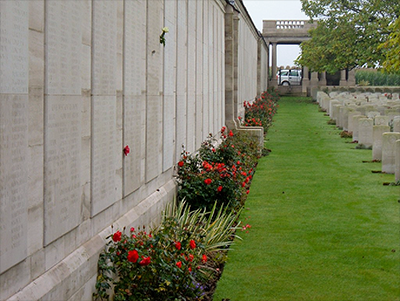 |
 |
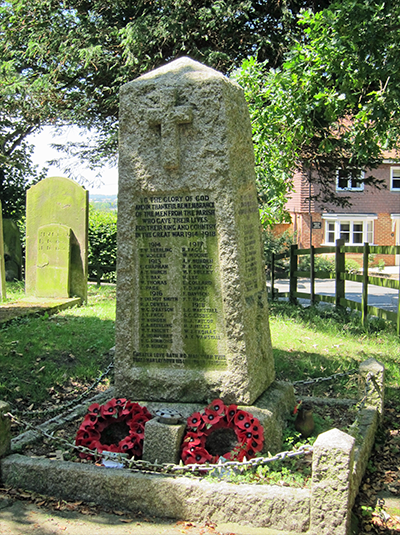 |
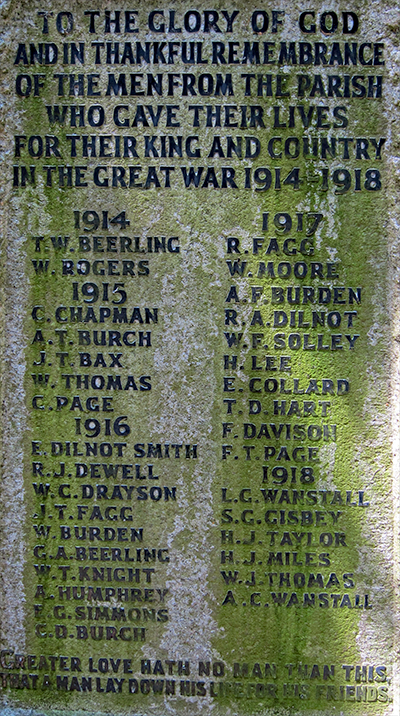 |
In addition to the Lynsted Memorial, William is also commemorated on the Woodnesborough, Kent, Civic War Memorial, which is situated in the churchyard of St Mary the Blessed Virgin, Woodnesborough, near Sandwich, Kent. Within this churchyard William is also remembered on the headstone of his parent's grave. In addition, he is remembered in the Deal, Walmer and Sandwich Roll of Honour.
William was posthumously awarded the 1914-15 Star, and the British War and Victory medals. [See Appendix 1]
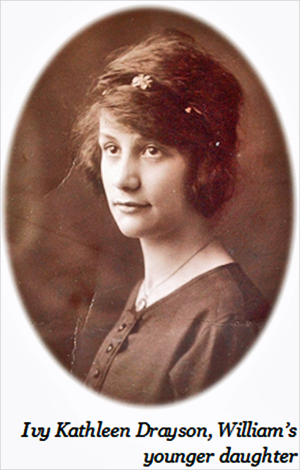 William's story illustrates sacrifices made, and the loss suffered by those at home. On his death, William's two young daughters, Ivy and Christina, were orphaned. On his posting abroad they had been sent to live with their maternal uncle Frank Weaver and his wife Alice, who were living at 4 Triggs Cottages, Teynham; the girls were enrolled in Lynsted School and remained with Frank and Alice Weaver, who became the legal guardians of William's 2 daughters.
William's story illustrates sacrifices made, and the loss suffered by those at home. On his death, William's two young daughters, Ivy and Christina, were orphaned. On his posting abroad they had been sent to live with their maternal uncle Frank Weaver and his wife Alice, who were living at 4 Triggs Cottages, Teynham; the girls were enrolled in Lynsted School and remained with Frank and Alice Weaver, who became the legal guardians of William's 2 daughters.
As legal guardian, Alice received £7 12s 6d (£7.62½p) in February 1917. In September 1919 Alice also received the War Gratuity of £6 10s (£6.50). [See Appendix 2] Taken together these amount to roughly £900 in today's money.
A year after their father's death, on 3 May 1917, Ivy and Christina's maternal uncle, Reginald Weaver, was reported missing in action. Reginald was the younger brother of Frank, with whom William's children had been sent to live. Reginald's death was confirmed on 18 April 1918 and he is also commemorated on the Lynsted memorial and in this book.
Four of William's brothers also served their country. Herbert served in the Royal Field Artillery and saw action in France, Italy and Egypt and survived malaria as well as being kicked in the eyes by a horse. Frederick also served in the Royal Field Artillery in India, where, in 1918, he survived the flu epidemic. Richard and Harry both served in the Army Service Corps. All four survived the war.
Ivy Kathleen Drayson, Younger Daughter of WilliamWilliam's father did not live to see the end of the war, dying at the age of 60 on 25 October 1918. William's mother died on 5 January 1939 aged 78 and is buried along with his father at Woodnesborough.
Ivy went on to marry Albert Bone in 1927. She died in Canterbury in 1971 aged 62. Christina was married and widowed 3 times, firstly in 1940, then in 1965 and 1989. She died in Canterbury in 1998 aged 91.
The photograph below shows Ivy Drayson's wedding day. Her older sister, Christina, is shown seated on the left.
Others in the photograph are:-
Back row from left: Herbert Drayson (older brother of William), Harry Bone (grooms older brother), Albert Bone (groom), Ivy Kathleen Drayson, Frank Weaver, Ivy and Christina's maternal uncle, Stanley Bone (groom's younger brother.)
Front row: Christina Drayson (left), Alice Weaver on far right (wife of Frank). The 2 young women are the Weaver's own children and the boys their grandchildren.
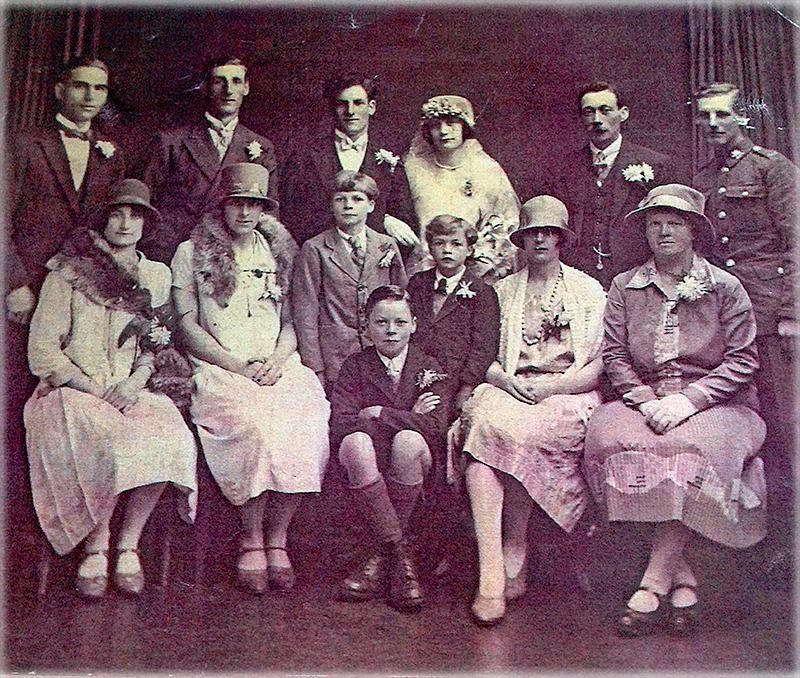
The Society is indebted to Julie Rutt, William's granddaughter, who has been able to clarify the family link to Lynsted. Also for the family photographs that she has kindly shared with us.

 World War 1 Pages
World War 1 Pages